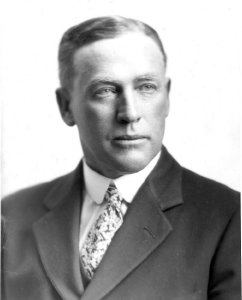Bert W. Huntoon
Berton Waldron Huntoon was born in Sacramento, California, on February 6, 1870, moving with his family to Seattle, Washington, in 1883. By age sixteen, Huntoon had joined a volunteer fire brigade in his new hometown and was a member of Seattle's championship hose-laying team of 1886-1887. Huntoon began his engineering career at eighteen, working at the City Engineer's office in Seattle for two years, and then working for a year with the Fairhaven & Southern Railroad (later Great Northern Railway). After attending the Rensselaer Polytechnic Institute in Troy, New York, Huntoon returned to Washington state.
Engineer
In July 1894, Huntoon was appointed as one of the official 'cruisers' of the Washington State Roads Commission. He and draftsman Harry M. Wellman were charged with determining the best route for the proposed Cascade State Wagon Road. Carrying 66-pound packs, they hiked along the South and Middle Forks of the Nooksack River, along the Baker River, and summited Mt. Baker on July 13, 1894. They made camp at more than 14 locations during their month long excursion, Huntoon documenting the "views" with his Kodak along the way. This summer would set the stage for Huntoon's lifelong twin pursuits of promoting Mt. Baker and photographing the local scenic beauty.
Huntoon served as assistant engineer of Whatcom County under J. J. Donovan, and in 1896 was elected Whatcom County civil engineer, serving two terms. In 1899, Huntoon became an engineer for what became Pacific American Fisheries (PAF) in South Bellingham. Huntoon would remain affiliated with the PAF for 45 years. In 1901, he was made superintendent of the operations in the Sound fisheries and of the salmon canneries at Fairhaven and Friday Harbor. That same year, "B. W." married Marguerite Wilcox. PAF's 1918 issue of The Shield describes Huntoon's ability to multi-task: "Oysters, roads, photography, fertilizer, fish traps, transportation, oil lands, dock construction, toredos, shipyards, fatty acid, foreign residue, political salmon history, proteins, albuminoids, country houses, lobbying - two or three at a time or all at once, B. W. fairly makes one's brain reel when in some thoughtless moment one allows him to get between one and the doors." In 1921, Huntoon became PAF's official photographer.
Civic Leader
While employed with the PAF, Huntoon was also active in other local endeavors. He was instrumental in the formation of the Mt. Baker Club in 1911 and served on its first finance committee. The Mt. Baker Club "was not to be an outing club … but, rather, a business organization for the purpose of opening up the mountain region." Its ambitious mission was "to make known and draw public attention to the unrivaled scenic beauties of the MT. BAKER REGION; to establish camps or resorts which will be available to mountain climbers, tourists and those seeking outdoor enjoyment and recreation; to construct trails and highways and to secure national, state, county and public aid for the construction of such roadways; and, to collect photographic and engineering data, general, historic, scientific, botanic, geologic, and, other information pertaining to said region."
In 1923, Huntoon became general manager of the Mount Baker Development Company, a position he would hold for ten years. As such, he was instrumental in the construction of the Mount Baker Highway, Mount Baker Lodge, and the development and promotion of the general area. The Mount Baker Lodge officially opened on July 27, 1927. The lodge had 100 rooms, 60 with bath and telephones, all electrically heated. Bungalows adjacent to the lodge accommodated 350 guests. Sadly, due to an electrical fire, the main lodge burned to the ground on August 5, 1931.
At the same time he was involved with the Mount Baker Development Company, Huntoon took an active part in the building of scenic Chuckanut Drive, and was a force in the campaign to include it in the state highway system. As a member of the city park board during the 1920s, Huntoon established Sehome Park, overlooking the Washington State Normal School at Bellingham, now Western Washington University. The original road, now a path along the western face of the hill, was named Huntoon Drive in his honor. (In 1974, Sehome Park was incorporated into the Sehome Hill Arboretum).
Huntoon was also a staunch Republican, member of the Order of Odd Fellows, Society of Civil Engineers, the Commercial Club at Fairhaven, charter member of the Rotary Club, a member of Fairhaven Lodge No. 73 F. & A.M., and director and member of the Chamber of Commerce. Huntoon died January 2, 1947, in Bellingham, having continued to promote his part of the country until his death.
An editorial tribute to Bert Huntoon in The Bellingham Herald called him a "MASTER BUILDER" and stated, "a quarter century ago Mr. Huntoon was one of a small group of public-spirited business and professional men who bore the informal title of Visionists - men who, frequently using their own resources, assumed voluntary leadership in the development of Whatcom County's scenic assets. Out of that sponsorship came Mount Baker Lodge and the Heather Meadows development. Without Mr. Huntoon's engineering skill, his flair for the artisitic, his unquenchable enthusiasm for bringing the beauty and grandeur of the community within reach of the people, this project would have been less imposing as a community asset."
Photographer
Throughout his lifetime, Huntoon was an avid amateur photographer who submitted many of his images to numerous and varied publications. As a result, according to one obituary, "his scenic pictures of Mount Baker, Mount Shuksan, Chuckanut Drive, the islands and many other parts of this area were given wide circulation, printed in the rotogravure sections of newspapers and in magazines, and helped to spread the scenic wonders of Bellingham and Whatcom County." The Whatcom Museum's photo archives contain more than 5,500 historic photographs and original negatives taken by Bert Huntoon, many bearing crop lines and notations in his bold hand.
